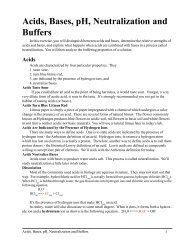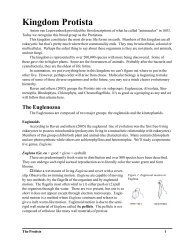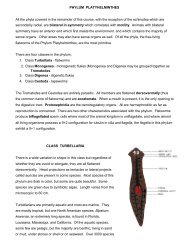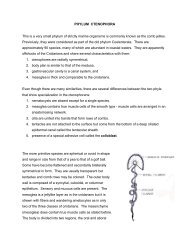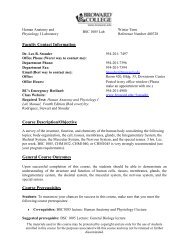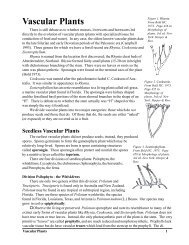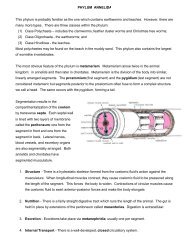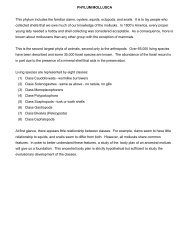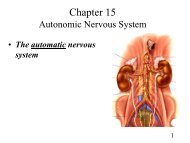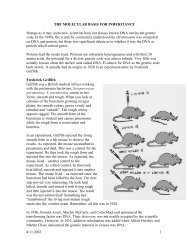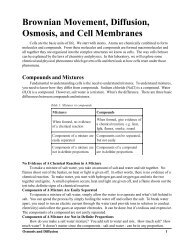Process Description of the Life Cycle of a Butterfly INTRODUCTION ...
Process Description of the Life Cycle of a Butterfly INTRODUCTION ...
Process Description of the Life Cycle of a Butterfly INTRODUCTION ...
Create successful ePaper yourself
Turn your PDF publications into a flip-book with our unique Google optimized e-Paper software.
<strong>Process</strong> <strong>Description</strong> <strong>of</strong> <strong>the</strong> <strong>Life</strong> <strong>Cycle</strong> <strong>of</strong> a <strong>Butterfly</strong><br />
<strong>INTRODUCTION</strong><br />
Subject<br />
Butterflies are winged insects that evolved from moths about 150 million years ago (Feltwell 1).<br />
Since that time thousands <strong>of</strong> species have evolved, becoming an indispensable part <strong>of</strong> our planet’s<br />
ecology. Butterflies provide a food source for a myriad <strong>of</strong> insects and animals, and have influenced<br />
<strong>the</strong> evolution <strong>of</strong> flowering plants (Douglas 177). This ecological importance extends throughout its<br />
entire life cycle.<br />
Audience, Purpose<br />
The life cycle <strong>of</strong> <strong>the</strong> common butterfly is a complex and fascinating process, yet one most people are<br />
unaware <strong>of</strong>. This report is intended to <strong>of</strong>fer general information on <strong>the</strong> life cycle <strong>of</strong> a butterfly for<br />
those interested in, but unfamiliar with, this process.<br />
Scope<br />
This report will explore <strong>the</strong> four stages <strong>of</strong> butterfly development: egg, larva, pupa and adult.<br />
COLLECTED DATA<br />
The Egg<br />
The first stage in <strong>the</strong> butterfly life cycle is <strong>the</strong> egg. These eggs come in a variety <strong>of</strong> colors and shapes,<br />
from spheres to cones to discs, and <strong>the</strong> shape <strong>of</strong> <strong>the</strong> egg can <strong>of</strong>ten identify <strong>the</strong> species. Butterflies<br />
might lay as few as 100, or as many as 2000 eggs on or near food plant (Douglas 9). Once <strong>the</strong>y are<br />
laid, <strong>the</strong> fertilized cells multiply very quickly. Nourishment is provided from a food supply in <strong>the</strong> egg<br />
itself . and oxygen and carbon dioxide are exchanged through pores or ducts in <strong>the</strong> egg shell. The<br />
eggs can hatch in as little as three days or suspend development until <strong>the</strong> following spring (14).<br />
The Larval Stage<br />
Like butterfly eggs, <strong>the</strong> larva, more commonly known as caterpillars, also come in many shapes and<br />
sizes. Most are wiener shaped but o<strong>the</strong>rs look like slugs, and still o<strong>the</strong>rs are covered with fur or<br />
spines. Whatever <strong>the</strong> differences, caterpillars do have common characteristics. They each have a well<br />
defined head with tiny antenna, mouth parts, and six pairs <strong>of</strong> primitive eyes (14).
The body <strong>of</strong> <strong>the</strong> caterpillar has thirteen segments. Three <strong>of</strong> <strong>the</strong> forward segments contain <strong>the</strong> clawed<br />
walking legs, at least one pair to each segment. The five pairs <strong>of</strong> grasping legs are located on five <strong>of</strong><br />
<strong>the</strong> ten rear segments (see figure 1). Most <strong>of</strong> <strong>the</strong> internal portion <strong>of</strong> <strong>the</strong> larva is dedicated to digestion<br />
(Douglas 16).<br />
The sole purpose <strong>of</strong> <strong>the</strong> caterpillar is eating. Immediately after hatching it begins to consume huge<br />
quantities <strong>of</strong> food. This singularity <strong>of</strong> purpose results in an extremely rapid weight gain. Mass<br />
consumption <strong>of</strong> food is necessary for <strong>the</strong> changes that will occur during <strong>the</strong> pupal stage (18).<br />
The Pupal Stage<br />
Figure 1 The <strong>Butterfly</strong> Larva<br />
Source: Golden Book <strong>of</strong> Insects<br />
The pupal stage occurs when <strong>the</strong> larva anchors itself to a branch or leaf, loses its outer skin and forms<br />
a hardened case called a pupa, around its internal organs (see figure 2). The purpose <strong>of</strong> this casing is<br />
to protect <strong>the</strong> larva as it undergoes <strong>the</strong> changes that transform it into a butterfly. The pupal stage is<br />
<strong>the</strong> bridge between larva and adult. In this stage complex biological changes are taking place inside<br />
<strong>the</strong> pupa. The larva is being chemically dismantled and its larval structures (legs, organs, antenna,<br />
etc.) are being rebuilt into adult structures. This process may take months or only a few days (Douglas<br />
25).<br />
Figure 2. The Pupa<br />
Source: Golden Book <strong>of</strong> Insects
Adult<br />
After <strong>the</strong> pupal stage is complete <strong>the</strong> adult butterfly will emerge from <strong>the</strong> pupa with shriveled wings.<br />
The wings are quickly pumped full <strong>of</strong> liquid from <strong>the</strong> butterfly’s body, causing <strong>the</strong>m to expand and<br />
stiffen into usable wings. At this stage <strong>the</strong> butterfly becomes <strong>the</strong> familiar brightly colored and intricately<br />
decorated insect that nearly everyone will recognize.<br />
The adult butterfly concerns itself mainly with mating and laying eggs. Soon after emerging from <strong>the</strong><br />
pupa, butterflies begin to search out a mate to insure <strong>the</strong> production <strong>of</strong> <strong>the</strong> next generation. A butterfly<br />
lives in <strong>the</strong> adult form from two weeks to ten months and most <strong>of</strong> this time is divided between<br />
mating and consuming <strong>the</strong> nectar <strong>of</strong> flowers. After <strong>the</strong> female has mated, she locates an appropriate<br />
site and lays her eggs. Then <strong>the</strong> entire cycle repeats itself.<br />
CONCLUSION<br />
The four stages <strong>of</strong> <strong>the</strong> butterfly life cycle: egg, larva, pupa and adult, encompass radical biological<br />
and chemical transformations which are excellent examples <strong>of</strong> <strong>the</strong> hidden miracles <strong>of</strong> nature (see<br />
figure 3).<br />
Figure 3. The Monarch <strong>Butterfly</strong>
Works Cited<br />
Douglas, Laura. The World <strong>of</strong> Butterflies, Buffalo, NY: Textile Bridge Press, 1990.<br />
Feltwell, John. Butterflies and Moths, New York: Dorling Kindersley, 1993.



